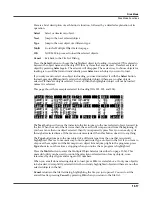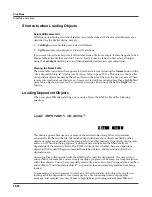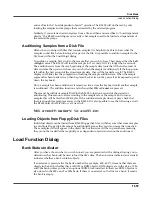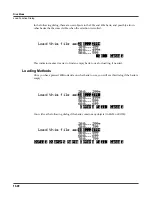
Disk Mode
Directories
13-5
Directories
A directory is a Þle on the disk that lets you group other Þles together as you might separate
documents using folders in a Þle cabinet. You can create directories on K2600 Format SCSI and
ßoppy disks. You can even create directories within directories; these are called subdirectories.
Directories are very useful for organizing your sample, song, and program Þles. The K2600
provides many operations for setting up and managing the directories on your disks and the
Þles within them.
Path
The Path Þeld shows the current directory on the current disk if it is a K2600 format disk. This
Þeld is displayed upon returning to the Disk-mode page after you have pressed one of the disk
function soft buttons and viewed the Þle contents of a speciÞc disk. It stays visible on the
Disk-mode page until you power down or do a soft reset.
The K2600 always starts at the root (top-level) directory when you power it up, or when you
change the value of the CurrentDisk parameter. When you use the disk functions to view other
directories, the Path Þeld updates the current directory value to track your movements.
The root directory is displayed as a backslash:
Path|=|\
If you press the
Load
button and load a Þle from a subdirectory called SOUNDS, the Path Þeld
will appear as
Path|=|\SOUNDS\
The backslash character is a directory separator, as in the following Path:
Path|=|\NEWTUNE\SAMPLES\DOGS\
This represents the directory DOGS, which is a subdirectory of the SAMPLES directory, which is
a subdirectory of the NEWTUNE directory in the root directory. If the path is too long to Þt on
the top line of the display, it gets abbreviated. The maximum length of a path in the K2600 is
64 characters (including the backslash characters).
Startup
The Startup parameter determines what disk will be used for loading the power-up macro Þle
BOOT.MAC
(see
Creating a Startup File
on page 13-69). If this is set to
None
, then the K2600 will
power-up in a normal fashion. If this is set to a SCSI device or
Floppy
, when the K2600 is next
powered on it will look for the
BOOT.MAC
Þle in the root directory of the speciÞed disk, and
load each of the entries in the macro speciÞed within.
This feature provides a very ßexible way to automatically conÞgure your K2600Õs memory
contents whenever you turn the power on.
Summary of Contents for K2600 BEST OF VAST - REV A
Page 76: ......





































